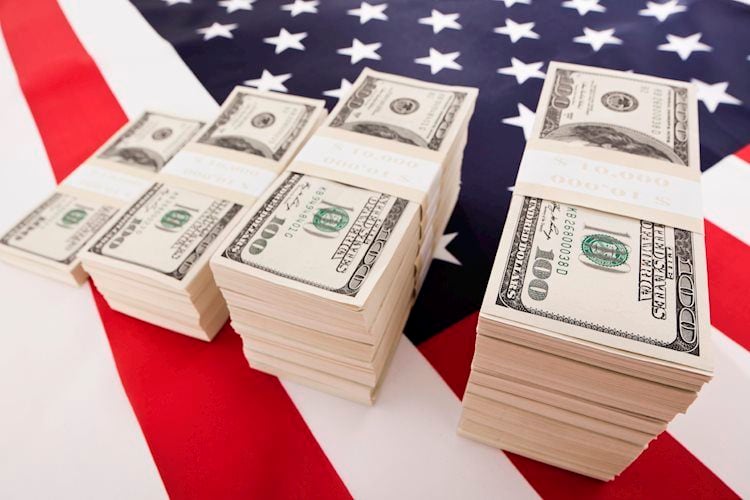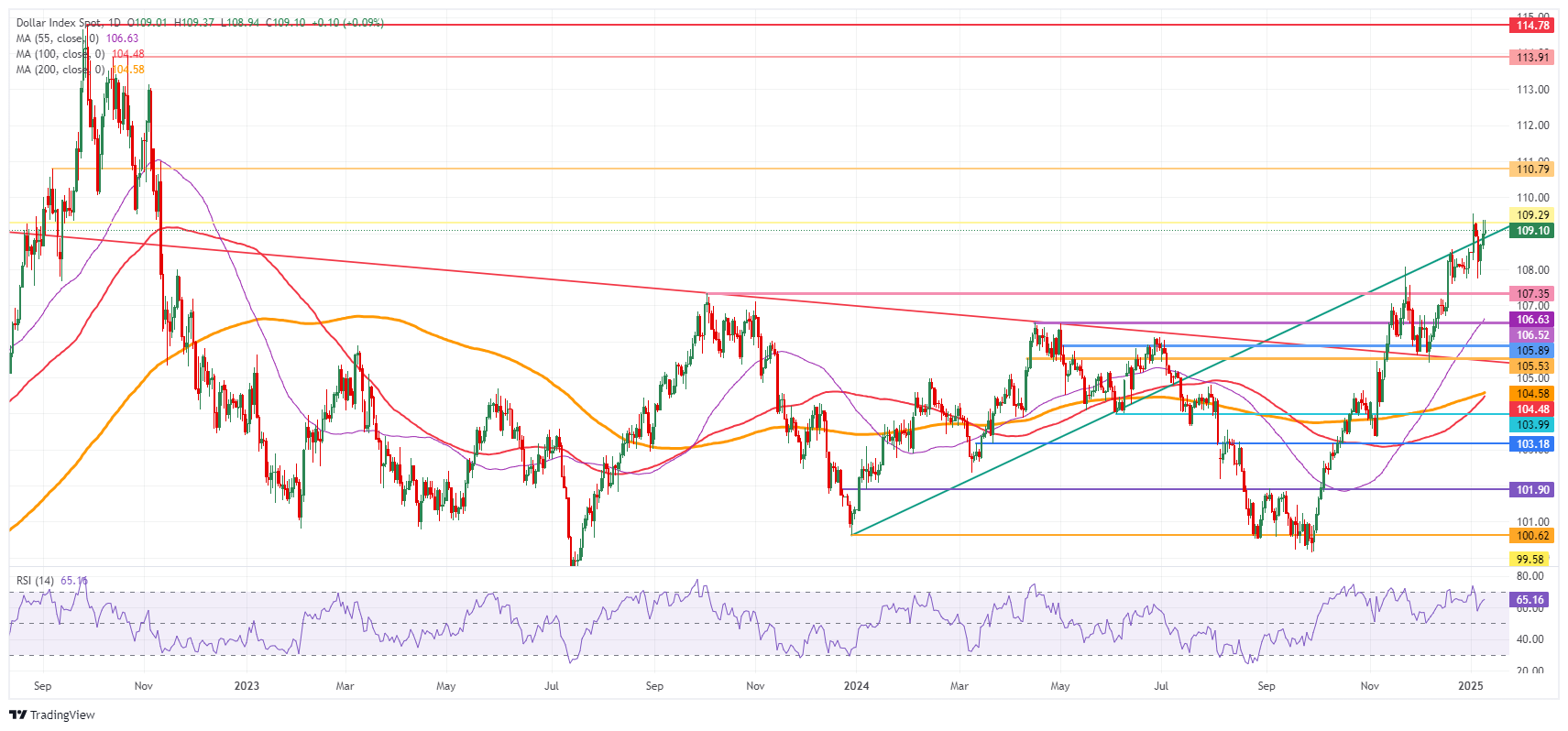- The US Dollar consolidating at current levels as inflation worries fade a touch.
- Inflation concerns are top priority, triggering a mini-crisis in UK Gilts.
- The US Dollar Index (DXY) hovers arond 109.00 in search of support.
The US Dollar Index (DXY), which tracks the Greenback’s value against six major currencies, trades flat above 109.00 on Thursday while bond markets are easing down after an already volatile week. Yields surged across the globe after traders started to worry about all the plans President-elect Donald Trump wants to implement, e most of them perceived as highly inflationary. This has triggered widening rate differentials between the US and other countries
The mentioned surges in yields triggered a brief mini-crisis in UK Gilts. This week, long-term UK borrowing costs have soared substantially and the British Pound (GBP) has fallen. Markets perceive this as a sign that investors have lost faith in the government’s ability to manage the national debt and control inflation, while the British government is soothing by communicating it will stick to its fiscal rules even if borrowing costs will hit their higest level since the financial crisis, the FT reports.
The US economic calendar is light, with a shortened trading day due to the National Day of Mourning for former President Jimmy Carter. The US Challenger Job Cuts number for December will get most of the attention, while four Fed members are set to speak.
Daily digest market movers: Not impressed
- US stock markets will remain closed or will be trading in shortened hours this Thursday in honor of former President Jimmy Carter.
- December Challenger Job Cuts came in at 38,792, softer than the previous 57,727.
- The Fed Minutes released on Wednesday showed Fed officials confirming a gradual and possibly longer steady rate before considering to cut further, Bloomberg reported.
- At 14:00 GMT, Federal Reserve Bank of Philadelphia President Patrick Harker speaks in Princeton right before the National Association of Corporate Directors New Jersey Chapter Economic Forecast 2025.
- Around 17:40 GMT, the Federal Reserve Bank of Richmond Thomas Barkin speaks to the Virginia Bankers Association and the Virginia Chamber of Commerce.
- At 18:30 GMT, the Federal Reserve Bank of Kansas City President Jeffrey Schmid delivers a speech on the economic and monetary policy outlook at the Economic Club of Kansas City.
- Around 18:35GMT, the Federal Reserve Governor Michelle Bowman will give a speech at the California Bankers Association 2025 Bank Presidents Seminar about 2024 reflections, including monetary policy, economic performance and lessons for banking regulation.
- Equities are having a change of heart again, with European equities and US futures turning green ahead of the US Opening Bell.
- The CME FedWatch Tool is projecting a 93.1% chance that interest rates will be kept unchanged at current levels in the January meeting. Further on, expectations are for the Fed to remain data-dependent with uncertainties that could influence the inflation path once President-elect Donald Trump takes office on January 20.
- US yields are softening a touch with the US 10-year benchmark at 4.65%, off the fresh nine -month high at 4.728% seen on Wednesday.
US Dollar Index Technical Analysis: Quick sprint and cool down
The US Dollar Index (DXY) seems to be stalling its rally just above 109.30 on Thursday. Although 110.00 is very near, the DXY might need to dip again back to 108.00 or lower in order to take out that 110.00 level in the next rally, as the market seems to have fully priced in all inflation elements for now.
On the upside, it is key that the green ascending trend line can hold as support, although that is often not the scenario going forward. If the DXY can head and break above the 110.00 psychological barrier, 110.79 becomes the next big level. Once beyond there, it is quite a stretch to 113.91, the double top from November 2023.
On the contrary, the first downside barrier is 107.35, which has now turned into support. The next level that might halt any selling pressure is 106.52, with the 55-day Simple Moving Average (SMA) at 106.63 reinforcing this region of support.
US Dollar Index: Daily Chart
Inflation FAQs
Inflation measures the rise in the price of a representative basket of goods and services. Headline inflation is usually expressed as a percentage change on a month-on-month (MoM) and year-on-year (YoY) basis. Core inflation excludes more volatile elements such as food and fuel which can fluctuate because of geopolitical and seasonal factors. Core inflation is the figure economists focus on and is the level targeted by central banks, which are mandated to keep inflation at a manageable level, usually around 2%.
The Consumer Price Index (CPI) measures the change in prices of a basket of goods and services over a period of time. It is usually expressed as a percentage change on a month-on-month (MoM) and year-on-year (YoY) basis. Core CPI is the figure targeted by central banks as it excludes volatile food and fuel inputs. When Core CPI rises above 2% it usually results in higher interest rates and vice versa when it falls below 2%. Since higher interest rates are positive for a currency, higher inflation usually results in a stronger currency. The opposite is true when inflation falls.
Although it may seem counter-intuitive, high inflation in a country pushes up the value of its currency and vice versa for lower inflation. This is because the central bank will normally raise interest rates to combat the higher inflation, which attract more global capital inflows from investors looking for a lucrative place to park their money.
Formerly, Gold was the asset investors turned to in times of high inflation because it preserved its value, and whilst investors will often still buy Gold for its safe-haven properties in times of extreme market turmoil, this is not the case most of the time. This is because when inflation is high, central banks will put up interest rates to combat it. Higher interest rates are negative for Gold because they increase the opportunity-cost of holding Gold vis-a-vis an interest-bearing asset or placing the money in a cash deposit account. On the flipside, lower inflation tends to be positive for Gold as it brings interest rates down, making the bright metal a more viable investment alternative.

